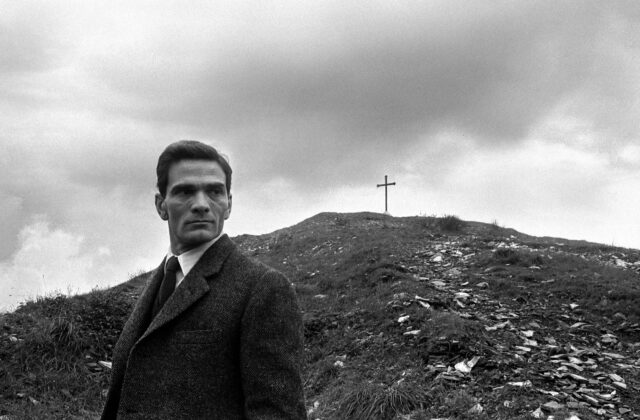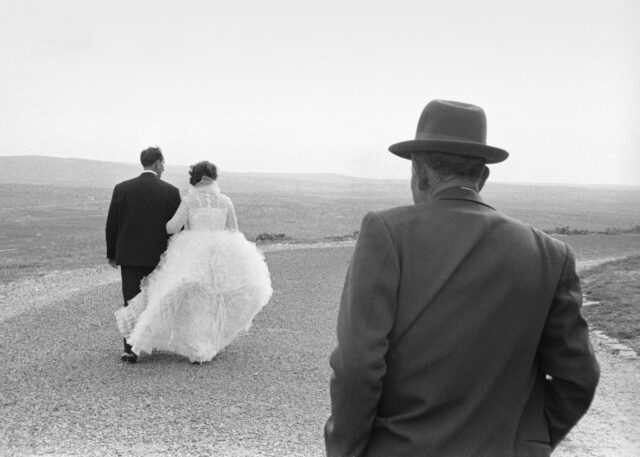
Paolo di Paolo’s photograph of Pier Paolo Pasolini at Monte dei Cocci in 1960 is one of many highlighted in Bruce Weber documentary
THE TREASURE OF HIS YOUTH: THE PHOTOGRAPHS OF PAOLO DI PAOLO (Bruce Weber, 2022)
Film Forum
209 West Houston St.
Opens Friday, December 9
212-727-8110
www.filmforum.org
“The mystery of Paolo di Paolo to me is that he was able to give up photography, something he once had such passion for,” documentarian Bruce Weber says at the beginning of the fabulous The Treasure of His Youth: The Photographs of Paolo di Paolo, a warm and inviting film about one of the greatest photographers you’ve never heard of.
In 1954, Italian philosopher Paolo di Paolo saw a Leica III camera in a shop window and, at the spur of the moment, decided to buy it. That led to fourteen extraordinary years during which the self-taught artist took pictures for Il Mondo and Il Tempo, documenting, primarily in black-and-white, postwar Italy as well as the country’s burgeoning film industry. He was not about glitz and glamour; he captured such figures as Luchino Visconti, Anna Magnani, Ezra Pound, Simone Signoret, Marcello Mastroianni, Charlotte Rampling, Alberto Moravia, Sofia Loren, Giorgio Di Chirico, and others in private moments and glorying in bursts of freedom. He went on a road trip with Pier Paolo Pasolini for a magazine story in which the director would write the words and di Paolo would supply the images. His photos of the society debut of eighteen-year-old Princess Pallavincini are poignant and beautiful, nothing like standard publicity shots.

Paolo di Paolo’s relationship with the camera is revealed in lovely documentary (photo courtesy Little Bear Films)
Then, in 1968, just as suddenly as he picked up the camera, he put it away, frustrated by the growing paparazzi culture and television journalism. A few years ago, Weber and his wife went into a small gallery in Rome where Weber, who has had a “love affair” with Rome since he was ten, discovered magnificent photos of many of his favorite Italian film stars. The gallery owner, Giuseppe Casetti, told him that the pictures were by an aristocratic gentleman he had bumped into at flea markets and who one day came into the bookstore where he was working and gave him one for free, knowing he was a collector. Casetti wanted to know who had taken the photo; “I was once a photographer,” di Paolo told him unassumingly.
That set Weber off on a search to find out everything he could about di Paolo, who is now ninety-seven. Even his daughter, Silvia di Paolo, had no knowledge of her father’s past as a photographer until she found nearly a quarter of a million negatives in the basement of the family home and began organizing them about twenty years ago. Paolo had never spoken of this part of his life; he wrote books on philosophy, was the official historian of the Carabinieri, and restored antique sports cars, but his artistic career was an enigma even though it was when he met his wife, his former assistant.

The father of the bride watches the young couple as they head down a country road (photo by Paolo di Paolo)
Weber follows di Paolo as he meets with photographer Tony Vaccaro, film producer Marina Cigona, and his longtime friend (but not related) Antonio do Paola, visits his childhood home in Larino, is interviewed by the young son of Vogue art director Luca Stoppini, and attends his first-ever retrospective exhibition (“Il Mondo Perduto” at the Maxxi Museum in Rome). And he picks up the camera again, taking photos at a Valentino fashion show.
Cinematographer Theodore Stanley evokes di Paolo’s unpretentious style as he photographs the aristocratic gentleman walking up a narrow cobblestoned street, his cane in his right hand, an umbrella in his left over his head, and driving one of his sports cars. Editor and cowriter Antonio Sánchez intercuts hundreds and hundreds of di Paolo’s photos, several of which are discussed in the film: a spectacular shot of Pasolini at Monte dei Cocci, the director in the foreground, the famous cross atop a hill in the background; Visconti in a chair, fanning himself; a scene in which a father, hands in his pocket, watches his daughter and new son-in-law walking away on an empty country road. There are also clips from such classic films as Rocco and His Brothers, Accatone, Rome Open City, Marriage Italian Style, and 8½. It’s all accompanied by John Leftwich’s epic score.
As Cigona tells di Paolo about having ended his flourishing photography career, “People said, ‘Why did you do that? You were quite famous.’” It was never about the fame for di Paolo, but now the secret is out.
“For me, every object is a miracle,” Pasolini says in an archival interview. In The Treasure of His Youth, Weber (Chop Suey, Let’s Get Lost) treats every moment with di Paolo and his photographs as a miracle. So will you.